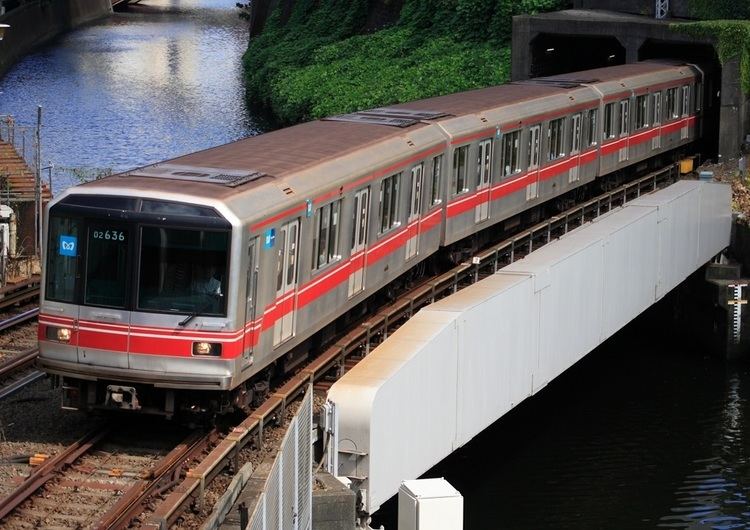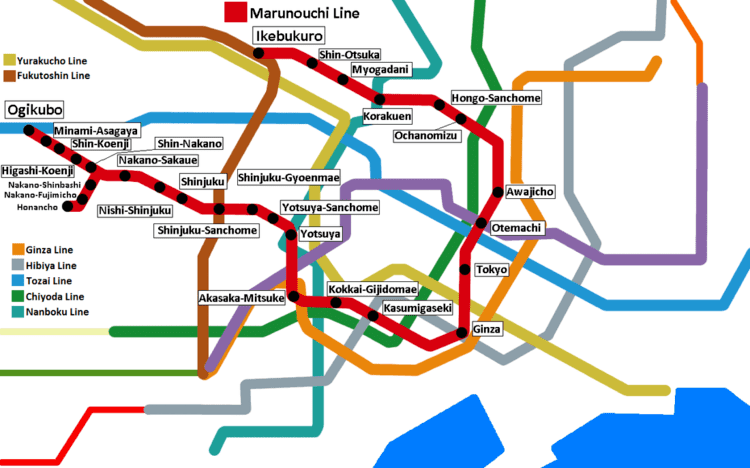Other name(s) Line 4 Opened January 20, 1954 | Native name 東京地下鉄丸ノ内線 Daily ridership 1,089,257 (FY2010) | |
 | ||
Stations 28 (including branch line) | ||
Tokyo metro marunouchi line at shinjuku gyoenmae station
The Tokyo Metro Marunouchi Line (東京地下鉄丸ノ内線, Tōkyō Chikatetsu Marunouchi-sen) is a subway line in Tokyo, Japan, operated by the Tokyo subway operator Tokyo Metro. The line runs in a U-shape between Ogikubo Station in Suginami and Ikebukuro Station in Toshima, with a branch line between Nakano-Sakaue Station and Hōnanchō Station. The official name is Line 4 Marunouchi Line (4号線丸ノ内線, Yon-gōsen Marunouchi-sen).
Contents
- Tokyo metro marunouchi line at shinjuku gyoenmae station
- Overview
- Station list
- Rolling stock
- Former
- History
- Future plans
- References

Overview

The Marunouchi Line is the second line to be built in the city, and the first one constructed after the Second World War. The route is U-shaped, running from Ogikubo Station in the west of the city via the commercial and administrative district of Shinjuku through to the Marunouchi commercial center around Tokyo Station, before turning back and heading to Ikebukuro. Along with the Ginza Line, it is self-enclosed and does not have any through services with other railway lines.

The Marunouchi Line is served by Tokyo Metro 02 series rolling stock in six-car trains on the main line, and three-car trains on the Hōnanchō branch. The main line is the most frequent subway line in Tokyo, with trains running at intervals of 1 minute 50 seconds during peak hours. In spite of such high-frequency service, according to a 2008 survey by the Ministry of Land, Infrastructure, Transport and Tourism the Marunouchi Line is one of the most crowded railway lines in Tokyo, running at 157% capacity between Shin-ōtsuka and Myōgadani stations. Its age and relatively short train length has made it one of the most crowded lines in Tokyo, although the 2000 opening of the Toei Ōedo Line has relieved the problem somewhat. In response to crowding, Tokyo Metro upgraded all stations with chest-high platform doors on March 28, 2009, a date on which it also began driver-only operation. The Hōnanchō branch switched to driver-only operation in July 2004.

Due to the age of the Marunouchi Line and the relative shallowness at which it runs, at several points in central Tokyo trains run at or above ground level. These include Yotsuya Station, the Kanda River near Ochanomizu Station (see image), and between Kōrakuen and Myōgadani stations.
On maps, diagrams and signboards, the line is shown using the color red (▉). Its stations are given numbers using the prefix "M"; Hōnanchō branch line stations carry the prefix "Mb", which replaced the previously used lowercase "m" prefix in November 2016.
Station list
All stations are located in Tokyo.
Rolling stock
Marunouchi Line services are operated using a fleet of 53 Tokyo Metro 02 series six-car EMUs in service since 1988 together with six three-car sets used on Hōnanchō branch services. All trains are based at Koishikawa and Nakano Depots.
A fleet of 53 new six-car trains is scheduled to be introduced from fiscal 2018, replacing the 02 series trains by fiscal 2022.
Former
History
The Marunouchi Line is the second subway line to be built in the city, and the first to be constructed after the Second World War. Its design is similar to that of the Ginza Line, the oldest subway line in Tokyo. Both lines are standard gauge and use third rail power, unlike subsequent Tokyo subway lines, which use overhead wires and are mostly narrow gauge to accommodate through services with other railway lines.
In a 1925 plan for a five-line subway system, the Marunouchi Line was planned to run from Shinjuku to Ōtsuka via Hibiya, Tsukiji and Okachimachi, as a 20 km (12 mi) underground route. A 1.2 km (0.75 mi) segment between Akasaka-mitsuke and Yotsuya began construction in 1942, but was abandoned in 1944 as a result of the continuing effects of World War II. On December 7, 1946, the Marunouchi Line was revised to begin from Nakano-fujimichō to the Mukōhara neighbourhood in Toshima Ward via Kanda and Ikebukuro, for a total length of 22.1 km (13.7 mi). On March 30, 1951, a groundbreaking ceremony was held at Ikebukuro Station East Exit to begin construction of the initial 7.7 km (4.8 mi) segment of the Marunouchi Line.
The first section was opened between Ikebukuro and Ochanomizu on January 20, 1954. The subsequent progress of the line was as follows:
The Marunouchi Line was one of the lines targeted in the Aum sarin gas attack on March 20, 1995. A plan to extend the Marunouchi Line from Ogikubo to Asaka City in Saitama Prefecture was rejected in the late 1990s.
Automatic train control (ATC) was activated on the Marunouchi Line on February 27, 1998, which allowed for an increase in the maximum operating speed limit from 65 km/h (40 mph) to 75 km/h (47 mph). This was followed by Train automatic stopping controller (TASC) which was introduced in November 2002, along with Automatic train operation (ATO) which was introduced on the main segment of the Marunouchi Line on December 27, 2008.
Future plans
The platform-edge doors at Hōnanchō Station, the terminus of the Hōnanchō Branch are due to be lengthened to allow 6-car trains to use the station, with work starting in 2013. Once completed, this will enable through trains to and from Ikebukuro to start operating all the way to Hōnanchō from fiscal 2017.
